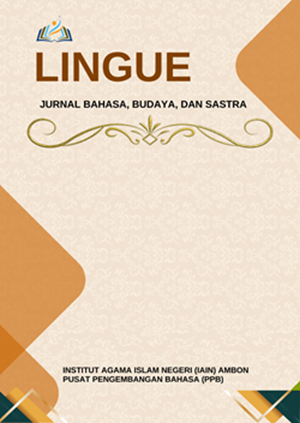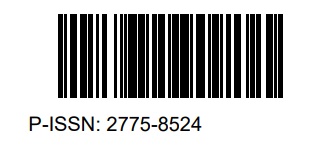PENGGUNAAN BAHASA KLISE DALAM IKLAN: PERSEPSI DAN EFEKTIVITAS KONSUMEN
DOI:
https://doi.org/10.33477/lingue.v4i2.4402Abstract
Abstract
This research aims to examine consumers' perceptions of the use of cliché language in advertising and the effectiveness of such language. The study employs a qualitative approach with a case study design, focused on respondents who have seen advertisements using cliché language. Purposive sampling technique was used to select relevant and representative respondents. The researcher conducted in-depth interviews with the respondents and observed their reactions to advertisements using cliché language. The results indicate that advertisements using cliché language tend to be more memorable to consumers. However, the effectiveness of using cliché language in advertising depends on the context of the advertisement and the suitability of the cliché language with the product being offered. Consumers' views on the use of cliché language in advertising can be influenced by psychological and social factors, such as creativity and originality of the advertisement. In this regard, it is important for marketers to pay attention to the brand image and message they wish to convey in their advertisements. Marketers can avoid the use of cliché language considered uncreative by developing more unique and original messages. The use of more creative and engaging language, such as metaphors or analogies, in advertising can enhance consumers' interest and attention to the advertisement and product.
Keywords: Advertising, Cliche Language, Consumer Perceptions, Marketing Strategy.
Abstrak
Penelitian ini bertujuan untuk mengkaji persepsi konsumen terhadap penggunaan bahasa cliché dalam iklan serta efektivitas penggunaan bahasa tersebut. Penelitian ini menggunakan pendekatan kualitatif dengan jenis studi kasus, yang difokuskan pada responden yang pernah melihat iklan yang menggunakan bahasa cliché. Teknik purposive sampling digunakan untuk memilih responden yang relevan dan representatif. Peneliti melakukan wawancara mendalam dengan responden dan observasi untuk mengamati bagaimana responden bereaksi terhadap iklan dengan penggunaan bahasa cliché. Hasil penelitian menunjukkan bahwa iklan yang menggunakan bahasa cliché cenderung lebih mudah diingat oleh konsumen. Namun, efektivitas penggunaan bahasa cliché dalam iklan sangat tergantung pada konteks iklan tersebut dan kesesuaian bahasa cliché dengan produk yang ditawarkan. Pandangan konsumen terhadap penggunaan bahasa cliché dalam iklan dapat dipengaruhi oleh faktor psikologis dan sosial, seperti kreativitas dan orisinalitas iklan. Dalam hal ini, penting bagi pemasar untuk memperhatikan citra merek dan pesan yang ingin disampaikan dalam iklan. Pemasar dapat menghindari penggunaan bahasa cliché yang dianggap tidak kreatif dengan mengembangkan pesan yang lebih unik dan orisinal. Penggunaan bahasa yang lebih kreatif dan menarik seperti penggunaan metafora atau analogi dalam iklan dapat meningkatkan minat dan perhatian konsumen terhadap iklan dan produk.
Kata Kunci: Advertising, Bahasa Cliche, Persepsi Konsumen, Strategi Pemasaran.
References
Avraham, E. (2020). Nation branding and marketing strategies for combatting tourism crises and stereotypes toward destinations. Journal of Business Research, 116, 711-720.
Chen, H. (2018). College-aged young consumers' perceptions of social media marketing: The story of Instagram. Journal of Current Issues & Research in Advertising, 39(1), 22-36.
Coleman, C. A., Zayer, L. T., & Karaca, Ö. H. (2020). Institutional logics, gender, and advertising within a culture in transition: Examining strategies of Advertising professionals in turkey for managing institutional complexity. Journal of Macromarketing, 40(4), 510-527.
Fox, A. K., Nakhata, C., & Deitz, G. D. (2019). Eat, drink, and create content: a multi-method exploration of visual social media marketing content. International Journal of Advertising, 38(3), 450-470.
Gatti, L., Stock, O., & Strapparava, C. (2021). Cognition and Computational Linguistic Creativity. In Handbook of Cognitive Mathematics (pp. 1-39). Cham: Springer International Publishing.
Gökerik, M., Gürbüz, A., Erkan, I., Mogaji, E., & Sap, S. (2018). Surprise me with your ads! The impacts of guerrilla marketing in social media on brand image. Asia Pacific journal of marketing and logistics.
Gonzalez, P. A., Ashworth, L., & McKeen, J. (2019). The CIO stereotype: Content, bias, and impact. The Journal of Strategic Information Systems, 28(1), 83-99.
He, L., Wang, R., & Jiang, M. (2020). Evaluating the effectiveness of China’s nation branding with data from social media. Global Media and China, 5(1), 3-21.
Kolbl, Ž., Diamantopoulos, A., Arslanagic-Kalajdzic, M., & Zabkar, V. (2020). Do brand warmth and brand competence add value to consumers? A stereotyping perspective. Journal of Business Research, 118, 346-362.
Lahman, M. K., Richard, V. M., & Teman, E. D. (2019). ish: How to write poemish (research) poetry. Qualitative Inquiry, 25(2), 215-227.
Lee, H., Chae, M. S., & Lew, Y. K. (2020). The application of categorization and stereotype content theories to country of origin image: Vietnamese perceptions towards Korean wave brands. Asia Pacific Business Review, 26(3), 336-361.
Licsandru, T. C., & Cui, C. C. (2019). Ethnic marketing to the global millennial consumers: Challenges and opportunities. Journal of Business Research, 103, 261-274.
Moldovan, S., Steinhart, Y., & Lehmann, D. R. (2019). Propagators, creativity, and informativeness: What helps ads go viral. Journal of Interactive Marketing, 47(1), 102-114.
Munsch, A. (2021). Millennial and generation Z digital marketing communication and advertising effectiveness: A qualitative exploration. Journal of Global Scholars of Marketing Science, 31(1), 10-29.
Nwankwo-Ojionu, C. E., Adzharuddin, N. A., Waheed, M., & Khir, A. M. (2021). Impact of Strategic Ambiguity Tagline on Billboard Advertising on Consumers Attention. Online Journal of Communication and Media Technologies, 12(1), e202204.
Peltier, C., Visalli, M., & Thomas, A. (2019). Using temporal dominance of emotions at home. Impact of coffee advertisements on consumers’ behavior and methodological perspectives. Food Quality and Preference, 71, 311-319.
Rahman, R. (2018). Building brand awareness: The role of celebrity endorsement in advertisements. Journal of Global Scholars of Marketing Science, 28(4), 363-384.
Sajib, M. N. F. (2020). Code-switching in advertisement posters: A sociolinguistic analysis. Belta Journal, 4(1), 44-57.
Schouten, A. P., Janssen, L., & Verspaget, M. (2020). Celebrity vs. Influencer endorsements in advertising: the role of identification, credibility, and Product-Endorser fit. International journal of advertising, 39(2), 258-281.
Teletov, A., Teletova, S., & Letunovska, N. (2019). Use of language games in advertising texts as a creative approach in advertising management. Periodicals of Engineering and Natural Sciences, 7(2), 458-465.
Wang, P., & McCarthy, B. (2021). What do people “like” on Facebook? Content marketing strategies used by retail bank brands in Australia and Singapore. Australasian Marketing Journal, 29(2), 155-176.
Yang, S., Carlson, J. R., & Chen, S. (2020). How augmented reality affects advertising effectiveness: The mediating effects of curiosity and attention toward the ad. Journal of Retailing and Consumer Services, 54, 102020.
Yoon, G., Li, C., Ji, Y., North, M., Hong, C., & Liu, J. (2018). Attracting comments: Digital engagement metrics on Facebook and financial performance. Journal of Advertising, 47(1), 24-37.
Downloads
Published
How to Cite
Issue
Section
License
If accepted for publication, the copyright of the article belongs to the author. Copyright includes the exclusive right to reproduce or transmit manuscripts in any form and media: reprint, produce photographs, microfilm, or translated versions of the manuscript. Increasing parts of this journal, storage and transmission of databases of any form or media, such as electronic copies, electrostatic and mechanical copies, photocopies, recordings, magnetic media and so on are permitted without permission. LINGUE: Jurnal Bahasa, Budaya dan Sastra, allow readers to read, download, copy, distribute, print, search, or link the fulltext of its articles and allow readers to use them for any other lawful purpose. However, it can not be used for commercial purposes
Jika diterima untuk publikasi, hak cipta artikel adalah milik penulis. Hak Cipta mencakup hak eksklusif untuk mereproduksi atau mengirimkan manuskrip dalam bentuk dan media apa pun: mencetak ulang, menghasilkan foto, mikrofilm, atau versi terjemahan dari manuskrip tersebut. Memperbanyak bagian jurnal ini, penyimpanan dan transmisi database dalam bentuk atau media apa pun, seperti salinan elektronik, salinan elektrostatis dan mekanis, fotokopi, rekaman, media magnetis, dan sebagainya diizinkan tanpa izin. LINGUE: Jurnal Bahasa,Budaya dan Sastra, memungkinkan pembaca untuk membaca, mengunduh, menyalin, mendistribusikan, mencetak, mencari, atau menautkan teks lengkap artikelnya dan memungkinkan pembaca untuk menggunakannya untuk tujuan yang sah lainnya. Namun, tidak dapat digunakan untuk tujuan komersial

LINGUE : Jurnal Bahasa, Budaya, dan Sastra Ciptaan disebarluaskan di bawah Lisensi Creative Commons Atribusi-TanpaTurunan 4.0 Internasional.







